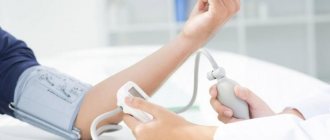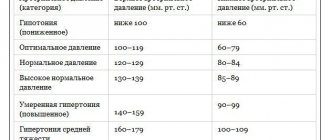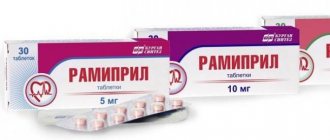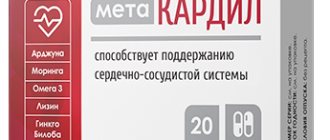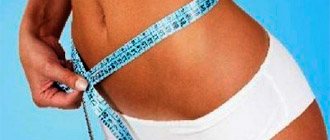While measuring your blood pressure with a tonometer, did you notice that your blood pressure is higher than normal? It is important to know what high upper pressure means and what consequences it can lead to in the future. You can talk about hypertension and the need for its treatment when the systolic reading regularly jumps up by 20–30 mmHg. Art. Moreover, it is the upper numbers that cause the appearance of characteristic symptoms. The lower levels may be normal or even decreased, but more often they increase almost synchronously. It is important to find out what causes blood pressure to rise, whether the pathology is a primary disease or reflects other processes in the body.
Diagnostics
Have you suspected or discovered that you have high blood pressure?
Make an appointment with your GP as soon as possible. The doctor will conduct an initial examination, which will allow you to establish an accurate diagnosis and select adequate treatment. In most cases, the diagnosis of systolic hypertension includes:
- Anamnesis collection . The doctor conducts a conversation with the patient regarding the existing symptoms of the disease, lifestyle, as well as the presence of concomitant pathologies. All this allows the specialist to make an assumption regarding the possible causes of the increase in upper pressure.
- Physical examination . It involves the doctor listening to the heart using a phonendoscope, during which the specialist has the opportunity to determine the presence of a murmur in the heart, disturbances in its sounds, and other associated abnormalities.
- ECG . The most popular diagnostic method for high systolic pressure, which allows you to confirm the diagnosis of “systolic hypertension”, as well as identify heart rhythm disturbances.
In some cases, the patient may be prescribed Holter monitoring (daily cardiogram).
- Ultrasound of the heart . An auxiliary diagnostic method, during which disturbances in the functioning and structure of the heart valves, and serious defects in the structure of the heart muscle are detected.
- Doppleography . _ A diagnostic method that allows you to assess the condition of the vascular system. With systolic hypertension, it is important to monitor the condition of the arteries leading from the heart to other organs and their systems.
- Laboratory research methods . Most often we are talking about a general analysis of urine, blood, and a blood biochemistry test that determines cholesterol and sugar levels.
If necessary, the therapist can refer the patient for consultation to specialized doctors - a cardiologist and an endocrinologist.
Symptoms of high blood pressure
There are no specific symptoms typical for hypertension. Therefore, sometimes, seemingly without apparent reason or alarm bells, strokes and heart attacks occur even in young people. And those symptoms that may indicate high blood pressure are ignored.
Among the common ones:
- headache in the temporal or occipital part of the head
- dizziness
- weakness and tremors
- nausea
- dyspnea
- blurred vision, flashing spots before the eyes
- tachycardia
- swelling (in case of increased lower pressure)
What is the danger?
The situation when systolic pressure increases one-time due to temporary reasons (for example, strong emotional overexcitation) is not quite dangerous. As soon as a person manages to cope with his experiences, the pressure normalizes on its own.
A frequent increase in the indicator is a rather dangerous phenomenon that can lead to all sorts of complications:
- hypertensive crisis;
- circulatory disorders in the brain - stroke;
- acute myocardial infarction;
- rapid development of heart failure;
- rapid development of irreversible kidney pathologies.
One of the most dangerous complications of increased upper pressure is the development of malignant hypertension. This pathology cannot be treated: 2-3 months after the development of the disease, the patient dies due to the appearance of associated complications.
Help with uncomplicated hypertensive crisis
- Stop physical activity.
- Sit or lie down with your head elevated and measure your blood pressure.
- You need to calm down and not panic (you can take tincture of valerian, motherwort).
- Restore your breathing - take a few deep breaths and exhales.
- If you have a hypertensive crisis for the first time in your life, you should definitely call an ambulance.
- Regardless of the type of hypertensive crisis, drugs with a rapid onset of the expected effect and a short elimination period should be used as self-help: captopril 25 mg; nifedipine 10 mg; moxonidine 0.2-0.4 mg; propranolol 10-40 mg.
- If the blood pressure level does not decrease or continues to increase, it is recommended to call an ambulance.
Why does blood pressure rise?
If high systolic pressure is observed with normal diastolic pressure, we should talk about the reasons for the unpleasant situation. Why does blood pressure increase:
- severe stress, emotional shock;
- excess weight;
- negative emotions;
- heredity;
- kidney diseases;
- taking certain medications.
An increase in blood pressure is not dangerous in a one-time event - you can easily get rid of it and forget about it. It is much more serious when it becomes a permanent illness. Chronically elevated upper blood pressure threatens:
- What do upper and lower blood pressure mean?
- impaired blood flow in the brain;
- stroke;
- anemia;
- acute heart attack;
- heart failure;
- kidney pathologies;
- malignant hypertension and death.
Symptoms of identifying indications of increased upper blood pressure with normal lower blood pressure:
- insomnia;
- swelling of the face (fluid retention);
- numbness of fingers;
- headache, dizziness, tinnitus;
- irritability, weakness;
- vegetative manifestations - anxiety, chills, red face, rapid pulse, lack of coordination.
Why is the upper pressure high and the lower normal?
The main factor in the development of a situation in which the upper pressure is increased while the lower pressure is normal is considered to be atherosclerosis of the aorta and its large branches. As you grow up and age, systolic blood pressure increases - the stiffness of the arteries increases, and the elasticity of the arteries decreases. Diastolic up to 50 years of age increases along with the upper one, but after the age limit it begins to decline, while systolic continues to increase.
The reason for this behavior is the stiffness of the blood vessels, the blood flows more slowly into the capillaries. This occurs due to the development of atherosclerosis, diabetes mellitus, thyroid diseases, valve insufficiency between the aortas and veins, and the formation of plaques. Increased blood pressure leads to isolated systolic hypertension. Every fifth elderly person suffers from this variant of the disease.
Drug groups
To maintain levels within normal limits in resistant patients, a combination regimen is recommended. The combination of several drugs can not only relieve high blood pressure quickly, but also reduce the risk of complications. List of drug groups for the treatment of hypertension:
- ACE inhibitors.
- Beta blockers.
- Nitrates.
- Diuretics.
- Calcium channel blockers.
- Alpha adrenergic blockers.
- Sartans.
Taking several tablets from different groups allows you to reduce the daily dosage due to the synergistic effect between them. Some regimens require a single dose of hypertension medication that can be taken throughout the day.
Beta blockers
Beta blockers lower blood pressure by reducing the effect of pressor amines (adrenaline, norepinephrine) on receptors located in the heart muscle. These drugs affect myocardial contractility and slow down the rhythm, which affects physical activity. Before you bring down high blood pressure, you need to count your pulse. This procedure is important in order to select the correct dosage and not further aggravate the problem by causing weakness of the sinus node. Blockers are good blood pressure pills, and depending on the degree of impact on the heart muscle, they are divided into several groups:
- cardioselective;
- non-selective.
Medicines of the first category selectively act on the myocardium. Their main advantage is to prevent the development and progression of insufficiency and reduce the manifestations of coronary disease. In addition, they slow the heart rate and the risk of sudden death.
Non-selective medications are contraindicated for patients suffering from bronchial asthma and chronic bronchitis with obstruction. Such beta blockers are not recommended for athletes and patients with atherosclerosis. For mild forms of the disease, the doctor prescribes the minimum dose, which will be the best solution in treating such patients. It is non-selective drugs that are included in the treatment protocol for chronic heart failure.
Effective high blood pressure pills from this group are most often prescribed to young people. If the drug is not combined with others, then therapy lasts no more than four weeks. Then, medications for hypertension that are suitable for the patient are combined with medications from other groups. This is necessary to create a long-term treatment regimen. The most commonly used medications are:
- "Bisoprolol."
- "Nebivolol".
- "Metoprolol."
- "Carvedilol".
Medicines in this group are not prescribed to patients with impaired conduction in the myocardium, no matter what their pressure is. For them, there are certain management tactics with a combination of other, no less effective means that quickly reduce the rate.
Alpha blockers
The therapeutic effect is achieved by influencing vascular receptors. As a result, the work of the sympathetic autonomic system is blocked. A decrease in the concentration of active amines allows the arterial walls to relax, which leads to a gradual restoration of normal blood pressure.
Tablets from this group are effective drugs for lowering blood pressure. Most often used:
- "Monoxidil".
- "Hydralazine."
Like any blood pressure medication, products in this category have disadvantages. After administration, the therapeutic effect is short-lived. Due to this, the risk of developing cerebrovascular accident or heart attack increases. Knowing how to quickly reduce blood pressure with pills, you need to be prepared for complications. A sharp drop in indicators leads to short-term tissue ischemia, which negatively affects the body. Most often, such jumps occur under the influence of a stress factor for a short time.
Diuretics
The task of diuretics is to remove excess salts and fluid from the body. These methods can quickly lower blood pressure and alleviate the patient’s condition. At the beginning of therapy, the diuretic effect is significantly pronounced. Many drugs from this group can not only reduce blood pressure, but also reduce swelling of peripheral tissues by removing electrolytes (potassium, magnesium). To maintain a normal balance of microelements, it is recommended to eat dried fruits, bananas or baked potatoes, or take medications that replace them.
Effective blood pressure tablets with a diuretic effect:
- "Hydrochlorothiazide."
- "Indapamide".
- "Furosemide".
- "Veroshpiron".
- "Torasemide".
- "Eplerenone."
To preserve potassium in the body and not take additional medications, you can take diuretics with a potassium-sparing effect. Of the entire list of tablets listed, only “Veroshpiron” and “Torasemide” retain it. If there is a deficiency of the element, patients experience severe cramps in the morning in the calf muscles and other symptoms of deficiency.
Depending on the severity and the drug that the doctor will prescribe, the best way to quickly bring down high blood pressure is to use a combination of diuretics with beta blockers.
Drugs affecting the central nervous system
Blood pressure lowering drugs in this category suppress the activity of the nervous system. As a result, inhibition of the formed reflex or its block at the stage of synaptic impulse transmission is observed. With their help, you can quickly reduce blood pressure in any stressful situation or when your condition worsens, which does not depend on provoking factors.
The best drugs among alpha stimulants:
- "Gemidon".
- "Dopegit."
- "Methyldopa."
The medications listed above are prescribed infrequently. They are necessary when it is impossible to eliminate the provoking factor by other means. Long-term use is not recommended due to the development of side effects. Normal symptoms are weakness and drowsiness after taking brain tissue stimulants. Constant treatment with drugs to quickly reduce blood pressure leads to memory and coordination problems. If therapy is delayed for several years, the drug can provoke the development of dementia or Alzheimer's disease.
ACE inhibitors
The purpose of the drugs is to block the synthesis of angiotensin II. The substances have a vasoconstrictor effect and also reduce heart weight, which leads to a decrease in hypertrophy (heart remodeling). These drugs not only quickly lower blood pressure. They have protective properties against organs that become the first target of hypertension.
If there is damage to the heart muscle, drugs for quickly reducing pressure gradually reduce their severity and improve the prognosis for life. The same effect is observed in heart failure with constant use.
The best medicine for high blood pressure is the one prescribed by the doctor when the patient visits in a timely manner in the early stages of the disease.
These include the following drugs:
- "Capoten", "Captopril", "Enalapril", "Diroton".
- "Physiotens", "Moxogamma", "Ebrantil".
- "Nifedipine".
- "Metoprolol", "Anaprilin".
The best medicine for hypertension in case of a sharp jump is Captopril. It is prescribed as a first aid remedy for hypertensive crisis. The drug should not be taken for a long time due to the high risk of mortality, hypotension and fainting.
At first, in the first days or week of treatment, unpleasant symptoms may appear. Fast-acting tablets for high blood pressure cause patients to feel weak and dizzy when changing body position. Some complain of a dry cough - the main reason for changing the medicine. Inhibitors are not recommended for pregnant women.
Nitrates
Nitrate-containing products are not the best blood pressure pills. They are not used as an independent drug. The hypotensive mechanism occurs due to vasodilation. Most often, Nitrosorbide and Nitroglycerin are used for this purpose.
Antispasmodics
In the absence of emergency aid, patients are worried about how to quickly reduce their blood pressure. Medicines from the group of antispasmodics effectively reduce vascular resistance. Of these, the best drugs are:
- "Papaverine".
- "Minoxidil."
- "Drotaverine".
It is important for every patient to know how to quickly lower blood pressure with pills on their own in order to avoid complications of hypertension.
Antispasmodics dilate small vessels and redistribute fluid circulating in the bloodstream. The result is a gradual decrease in pressure. Before reducing the pressure, it is necessary to measure its level. At high rates and severe forms of the course, antispasmodics are ineffective. Therefore, agents will be needed that have an inhibitory effect on the vascular center.
Calcium channel blockers
Calcium is needed to maintain the tone of the vascular wall. An increased concentration of a microelement promotes muscle contraction. In order to reduce it, drugs that are antagonists of the channels through which it enters cells are used. Low calcium levels relax the vessel wall, which allows pressure to be relieved that exceeds the permissible values.
Most often, patients with hypertension are prescribed the following medications:
- "Amlodipine."
- "Nifedipine".
Before you start treatment, you need to figure out which blood pressure pills are best. The drugs are divided into several groups depending on the duration of action and the severity of the effect.
Blockers with a short effect are preferable to use to relieve an attack of hypertensive crisis. They allow you to quickly lower blood pressure at home. For long-term treatment, retard-acting (long-acting) drugs are used.
Sartans
Drugs in this group have the ability to block specific receptors. As a result, they lower blood pressure for 48 hours. Dry cough, as a side effect, never bothers patients. Sartans do not cause a reaction associated with withdrawal syndrome (which is typical for beta blockers) and “slip-out” (“minus” of ACE inhibitors). The best remedy for hypertension, with its good effectiveness and tolerability, becomes the optimal choice for patients who are forced to take medications daily. Most often used:
- Telmisartan.
- "Losartan."
- "Valsartan".
- "Candesartan".
The peculiarity of the tablets is to relieve spasm from the vascular walls. This allows them to be prescribed for the treatment of hypertension of renal origin.
Sympatholytics
When the pressure is high and does not decrease, no matter what drug is used, drugs that depress the vasomotor center are prescribed. Many of them are used rarely, which is associated with the likelihood of addiction. The best drug for normalizing indicators is Clonidine. For elderly people in crises, it is prescribed as a first aid remedy. You can quickly reduce blood pressure with other tablets from the sympatholytic group:
- "Andipal".
- "Moxonidine."
- "Aldomed."
- "Reserpine".
- "Dopegit."
Reserpine is widely used for therapy due to its affordable cost, but it has a large number of side effects. Therefore, this remedy is recommended to be used only as a last resort. A rapid reduction in pressure is achieved in mild cases of hypertension with the help of Moxonidine and Andipal.
Definition
Systolic pressure is called top pressure because it is the top number on the sphygmomanometer screen. This indicator characterizes the pressure that occurs at the moment of contraction of the heart muscle - at the moment of blood ejection from the heart into the arteries.
Doctors call a condition in which the upper blood pressure (BP) is elevated systolic hypertension. Most often, this situation is observed at a time when the lower pressure remains within the normal range and does not go beyond 90 mmHg. Art., and the upper one is determined at a level of 140 mm Hg. Art. and higher.
In 90% of cases, the increase is diagnosed in elderly people who have crossed the age mark of 50 years. Most often, women who have concomitant diseases of the cardiovascular system are at risk.
- High lower pressure - causes and treatment with drugs and folk remedies
What does the difference between upper and lower pressure mean?
If a significant difference between systolic and diastolic pressure appears due to a feeling of hunger, hypothermia, excessive physical activity combined with insufficient nutrition or constant stress, this does not mean that pathology is developing in the body. When the effect of these factors disappears, the indicators may well return to normal, and there will be no cause for concern. But if the gap between the upper and lower pressure remains at rest, this may already indicate disturbances in the functioning of the heart, blood vessels, or other body systems.
A difference of less than 25% of the upper pressure may indicate several pathological conditions:
- Myocarditis;
- Left ventricular stroke;
- Tachycardia;
- Failure of internal organs;
- Aortic stenosis;
- Heart failure;
- Heart attack due to physical overexertion;
- Cardiosclerosis.
Such conditions are often accompanied by symptoms that are difficult to ignore. These are drowsiness and weakness, headache and dizziness, impaired attention and irritability. This situation can result in hypoxia, blurred vision, and sometimes cardiac arrest, so it should never be ignored. Such indicators on the tonometer screen and poor health require medical consultation and examination.
The difference between the upper and lower pressure exceeding 50 units is considered too large. The main causes of this condition are wear and tear and aging of the cardiovascular system. In such cases, tremors of the limbs and dizziness occur, the person becomes irritable or feels complete apathy, and fainting often occurs. Causes may also include pathologies of the digestive organs or gall bladder, and tuberculosis. Only a doctor can establish the true causes and prescribe effective treatment.
Any regular or prolonged deviation of systolic and diastolic pressure from the norm is a reason to pay close attention to your health. And it doesn’t matter whether we are talking about an increase or a decrease - both options can be dangerous.
How to reduce high blood pressure at home
High blood pressure is a very serious symptom. Therefore, any therapy should be prescribed strictly under supervision and on the recommendation of a specialist!
However, regular blood pressure medications should be in your home medicine cabinet, especially if there are real prerequisites.
- If the increase in pressure is situational in nature and caused by emotional or nervous shock. First of all, you should balance your breathing, find ways to calm down and relax as much as possible. Among the medications you can use: sedatives of plant origin, for example: novo-passit, persen, valerian tab, motherwort extarct tablet and others.
- To reduce blood pressure, diuretics can be used as part of complex therapy or as an independent remedy: Their selection and prescription, as well as the choice of dosage, is carried out by the doctor.
- If hypertension is an established chronic disease and another attack occurs, it is important to take as quickly as possible: Emergency drug Captopril 25 mg sublingually 0.5-1 tablet, and consult a doctor as soon as possible.
Diagnosis is like a detective
Another feature of such hypertension is that it does not have specific symptoms and can be suspected only by certain signs. For example, in 30% of such patients, the concentration of potassium in the blood is usually low, and sodium, on the contrary, is closer to the upper limit of normal. Another warning symptom is frequent urination and thirst. Often there is sleep apnea syndrome - short-term stops in breathing during sleep. This condition is one of the four most common causes of secondary hypertension, after kidney disease and elevated aldosterone. The patient himself may not notice apnea, but will suffer due to drowsiness and fatigue during the day. More often, such conditions occur in obese people. In case of untreatable hypertension, when the patient sometimes takes three or more medications, but they do not reduce the pressure, sleep apnea must be excluded.
Every six months - ECG and once a year ultrasound. Examination schedule for hypertensive patients Read more
Returning to elevated aldosterone, I note that the detection of high aldosterone is not a final diagnosis. After this, endocrinologists perform a special test with saline solution. If it is positive, then you need to find the cause of the increase in aldosterone and determine which adrenal gland is to blame. The first step is a computed tomography scan of the adrenal glands. But even if no changes are found in them, this does not mean that they are healthy. In the next step, it is important to determine whether aldosterone synthesis is increased in only one adrenal gland, left or right, or on both sides. After all, if only one is involved, it can be removed, and this can radically cure the person. To do this, aldosterone is determined separately in the veins extending from these endocrine glands. If an increase is observed on both sides, then drugs are prescribed that block the action of aldosterone and its toxic effects. Experience shows that this helps not only reduce blood pressure, but also improve the quality of life and prognosis in patients with such hypertension.
